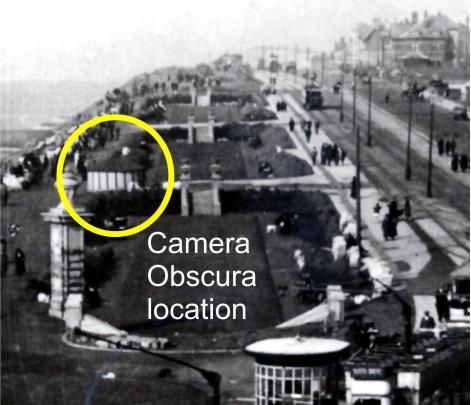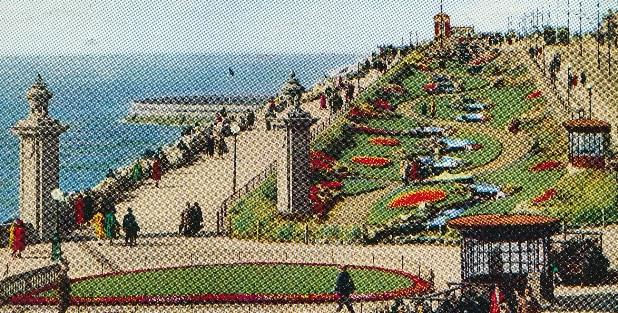


19th October 1923 PARKS AND CEMETERY COMMITTEE
RESOLVED: That the borough surveyor and the parks superintendent be instructed to prepare a scheme for submission to this committee showing an improved layout of the Gynn Gardens.
19th October 1923 PARKS AND CEMETERY COMMITTEE
READ: Letter of the 10th October 1923, from the borough surveyor making certain suggestions for the removal of rockwork at the Gynn Gardens and the refixing of same on the face of the cliff, which suggestion the committee adopted.
In 1925, when the Gynn Colonnades were built below the gardens, four ventilation shafts were also installed above to vent the new modern underground screening station and storage tank. The ventilation shafts were disguised as elaborate stone pillars, with ornate urns at the top. Around the middle section of the urn, holes can be seen, which were the ventilation holes and the stone pillar was hollow inside. The equipment of the screening station consisted of a three-eighth inch fine mesh rotary drum screen twelve feet in diameter for the dry weather flow and a three-eighth inch raking screen for storm water, the screenings being pumped up to tank wagons at roadway level. Mechanical ventilation was also be provided and all the plant were of the most modern type and electrically driven. Roughly estimated to cost £9000. To accommodate the new ventilation shafts, the southern steps were removed and replaced with a new east and west set of steps.
In 1925, a camera obscura was briefly installed in the gardens and was properly relocated from the recently declining Uncle Toms Cabin Entertainment complex further up the promenade. When the original Uncle Toms Cabin was demolished in 1907, many of the Showmen, Entertainers and Gypsies stayed near the site for many years afterwards.






17th December 1926 PARKS COMMITTEE
The parks superintendent submitted a plan showing a remodelling of the sunken gardens north of the Gynn, of which the committee approved.
During the remodelling of the gardens in 1928, 13ft was taken from the westerly pathway and incorporated into the new design. In the original design, the ventilation colomns were located on the edge of the garden boundary but in the 1928 remodel, the column were now located inside the garden footprint. The 1928 remodelling included a meandering stream running from north to south of the gardens, with a decorative pyramid stepped waterwall feeding the stream by the northern entrance. The waterfall became a main feature site for Blackpool Illuminations during the years, as well as the whole gardens being turned into an illuminated spectacular during the autumn months.
Up until the mid 1960’s, the gardens had no brick boundary wall, instead being either totally open or using link chain fencing.
During the 1980’s, the gardens would regularly receive approx 50,000 plants a year to fill the area with colour and imaginative designs.
In 1992, the orginal waterfall steps were removed, which briefly exposed the secret room hidden behind them. The entrance was located by going down a hidden hatch to the right of the waterfall. Blackpool Illuminations used this room to rear illuminate the steps.
STREAM REMOVED
In 2002, the stream was filled with top soil and turfed over to ease maintenance of the gardens
NEW SEATING AREAS
During 2004, two seating areas created within the gardens, with the first of the Memorial benches and a decorative obelisk.
WISHING WELL REMOVAL 2005
Rotary Club of Blackpool North Wishing Well removed from the gardens
NEW ENTRANCE ARCH
In 2005, Southern entrance metal arch installed
NEW BOULDER EDGING
In 2008, leftover boulders from the Blackpool Sea Defences Project were donated by Birse Construction to create edging to the planting beds along the length of the gardens.
LUMIDOGS
26th September 2014 The very first Lumidogs competition was staged in the gardens by LeftCoast, as part of Blackpool Illuminations Festival of Light.
CENTINARY
The gardens reached 100 years old in 2015.
BLUE LIGHT EMERGENCY SERVICES MEMORIAL INSTALLED 2013
The Gynn Square Memorial Committee formed in September 2008 after Dana Gledhill rightly expressed concerns about the neglected state of the garden at the Gynn previously known as the Jubilee Garden, and before that as the sunken gardens, and before that the Illuminated gardens. The garden incorporates a plaque to the 3 Police Officers who drowned nearby in 1983. The neglected state of the garden was not thought respectful, and the desire to have a more fitting monument for all emergency service workers recognised. Meetings were held with Julian Kearsley and others from the council. Support has also been gained from the local councillors, and emergency service staff organisations. An emergency services committee was formed of serving and retired officers from the Police, Fire and Ambulance services and the desire to have a fitting memorial to those who had died, who serve, or who may die in the course of serving the people of the Fylde Coast was formed. 14 fund raising events have been held since. These include the now annual Blue Light Ball, a Sportsmans dinner, Quizzes, Fun Runs etc. Numerous meetings with the council have been attended to improve the gardens, and establish a fitting memorial feature.
The site of an old tram shelter within the garden was identified as a suitable site. The figures of the monument will face inland and be illuminated, to be visible 24/7 from persons on the trams, pavement or road, while supporting interpretation boards are also proposed to be installed within the gardens at a later date. In 2010 a design competition was organised with Blackpool and the Fylde College, and a winning design of 5 linked figures cast in metal, designed by Mathew Titherington was chosen. The committee while liking the design, were not keen on the rusted metal finish, and the chosen site could only accommodate 4 figures of a decent size, so the group pursued their options inviting local stone masons to their meetings, knowing that granite would survive the harsh Blackpool winters. Stainless steel was found to be unaffordable. Enquiries were made with the designer of the armed services memorial at Wooton Bassett and established that to be bronze on sandstone, neither substance was deemed suitable for Blackpool weather/thieves. Other materials and options for the monument design were then considered. Granite, could not be guaranteed that the outstretched arms would not break off if somebody swung on them etc. MPM were approached due to them being local marine metal work experts, they suggested a Perspex monument made by their expert Alan Dawson. Alan attended various meetings and produced 2 models and an ‘arm’ to show the committee the structure with its coated steel skeleton structure within the Perspex. It was established that London buses and other long lasting items are now made of perspex whose really only drawback is that it will burn. The committee have thus far raised circa £30,000 towards the monument cost, while George Cox & Sons have kindly offered to provide the foundations and project manage.
FRIENDS OF JUBILEE GARDENS (GYNN) FORMED.
In May 2016, the friends group was formed to help with the maintenance and development of the gardens
WATERFALL RESTORATION
During 2016/7, the broken waterfall pump was replaced and leaks repaired to enable the waterfall to once again run in the gardens.
ORIGINAL 1928 WATERFALL ROCKERY RESTORATION
In 2017, with the help from the DWP 10,000 Community Volunteers, the original 1928 Rockery was re-established in the gardens. This involved removing the turf from the top, digging down to the rockery boulders hidden underneath and planting up the new beds.
























